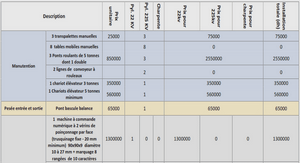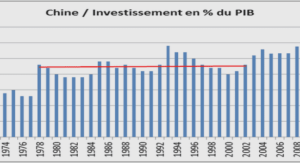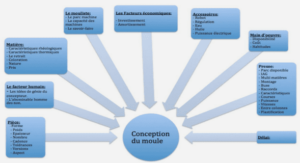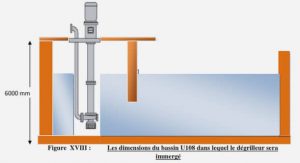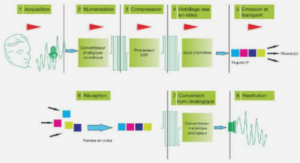Télécharger le fichier original (Mémoire de fin d’études)
Problem causing microorganisms in waste sewage water
Following are the micro organisms which cause problem for external environment.
Coli-form bacteria
Coliform bacteria occur throughout the environment. They may be present in soil and surface water. High amounts of coliform bacteria occurs because of waste from animals and human. Coliform bacteria cause mild illnesses and waterborne diseases. It is of rod shaped. In warm blooded animals´ feces, coliform bacteria are present in abundant amount. These are also present in soil as well as in aquatic environment. In the warm blooded animals feces many other pathogenic organisms are also present including protozoa, viruses, multi cellular parasites and bacteria. Diseases which are formed by the coliform bacteria are dysentery and typhoid fever. (13)
Coliform bacteria can enter the animal’s body by nose, ear, mouth or cuts in the skin. (13)
Viruses
In the human animal’s fecal wastes and urine almost all types of viruses are present. Most important varieties of virus are respiratory and enveloped enteric viruses. Viruses present in semi solid animals and human waste can be contaminated in air if the waste is not properly disposed off. At high temperature viruses are inactive. But at low and moderate temperature and pH, viruses can live for considerable time. It varies from hours, days and until weeks. Overall virus growth is inversely proportional to temperature. Virus can be inactivated at different temperature but there becomes varies of time with increase or decrease of temperature. Viruses become inactivated after 15 weeks at a temperature at 5 ºC. Similarly at temperature 20 ºC it is inactivated after 2 weeks. Under mesophilic conditions, viruses are inactivated after 5 hours. Also at thermal conditions it stops working at 55 ºC. (2)
Studies have shown that virus of human waste have the ability to survive in soil when water is supplied for agriculture purposes.
Parasites
The parasites are the organisms which depend upon other organisms for their food and survival. According to world health organization (WHO), 3.5 billion people suffer from infections caused by parasites. Giardia lamblia and Cryptosporidium are two of these parasites and they cause stomach problem, slight fever and diarrhea. Round worms are also parasites and they cause stomach pain, trouble in breathing and coughing. World-wide 0.6 to 4.3% of humans are infected by Cryptosporidium and 1.5 to 20% humans are infected by Giardia. Cryptosporidium and G. lamblia are two wide spread parasites. Entry of these in poor countries takes place because of poor sanitation. The entry of G. lambia or Cryptosporidium may take place from person to person or by focally contaminated food. Transmission of them may also take place because of contaminated drinking or recreational water. (3) In Sweden, recently two outbreaks of Cryptosporidium-caused illness have been reported to come from municipal drinking water, where the surface water source had become contaminated. (35) This parasite is also very resistant to chemical disinfection.
Giardia genus cause problem in public health. These both parasites may easily live in water treatment systems. (18)
Fungi
There are very many species of fungi. Fungi are considered to be plant with not having chlorophyll. Fungi do not make their own food and they are dependent upon other sources for their food. They mostly grow on dark places. They usually use dead matter for food. Fungi use trash as their food and make it in to the soil. Otherwise without fungi there would have been piles of trash every place. Alternaria is one another fungi in the environment. Spores of Alternaria are sources of allergens in the atmosphere generally causing respiratory problems. Chaetomium is another fungus that is present in 80 different species. It grows in interior buildings and also on plant debris. Fungi are used in medicine making antibiotics like penicillin. (19)
Biological Oxygen Demand (BOD)
Biological Oxygen demand measures the amount of organic material in water. Biological oxygen demand is the amount of oxygen that will be used by bacteria to decompose organic matter under aerobic condition. High BOD indicates polluted water and low BOD value good quality of water. Dissolved oxygen is the amount of oxygen present in water in dissolved form. Dissolved oxygen is very important for aquatic life. If amount of dissolved oxygen becomes low below a certain level, the aquatic life and fish are unable to survive. When organic matters are added to the water sources it causes an increase in biological oxygen demand (BOD). Dissolved oxygen can be measured in parts per million or milligram per liter. Amount of dissolve oxygen requirement is different for different species. Trout needs 8 mg/per liter. Minimum dissolve oxygen requirement for most of warm water fishes is 2 mg per liter. Dissolve oxygen requirement for striped bass is preferably to be at least 5 mg per liter. (14)
Micro organisms (bacteria and planktonic organisms) contribution in waste water treatment of marshes
The microorganism community is named as periphyton. Periphyton is a complex mixture of heterotrophic microbes, cyanobacteria and algae. Periphyton have important role in water quality. Periphyton in aquaculture system is used for removal of dissolved and solid pollutants. Periphyton is also considered as a source of food for many animal plankton, tadpoles, fish and invertebrates.
Bacteria working in decomposition of organic waste
Bacteria decompose organic matter present in the marsh by two processes
Anaerobic digestion
Organic waste + water ——Enzymes——->water soluble nutrients —–Bacteria—> water + carbon dioxide+ methane
Aerobic digestion
Organic waste + water —–Enzymes—-> water soluble nutrients + —-Bacteria—> water + carbon dioxide
In both cases enzymes act to make the organic matter into water soluble form and then bacteria act and use it for their food and leave methane, carbon dioxide and water. (28)
Enzymes
Bacteria and enzymes break down organic waste into carbon dioxide and water. Bacteria use the organic waste for their growth and reproduction. Through a complex reaction organic molecules in waste are decomposed into water, carbon dioxide and methane and it provides energy to bacteria to sustain their life. Enzymes are chemical catalysts and they are used to decompose complex waste into smaller molecules. The smaller molecules can be digested by bacteria.
Enzymes are chemicals and they are used and produced by bacteria for digestion of waste. When these enzymes are added to organic waste, they immediately work to break down the waste. Organic waste after breakdown is prepared food for bacteria to consume. After it growing bacteria generate and produce their own enzymes to keep cycle in working position. (28)
Removal of phosphate and nitrate from waste sewage water in marsh
Two main nutrients found in waste water are nitrogen and phosphorus. High amount of nitrates present in drinking water and surface water may cause health effect in human being and eutrophication in water bodies. Marshes and constructed wetland have the ability to reduce the level of nutrients in the waste domestic sewage water. For the removal of contaminants all process like physical and biological process are combined together in wetland for the removal of contaminants from waste water. Waste water treatment in a marsh occurs when this waste water passes through rhizosphere plant and medium of wetland. (21)
In the past for many years marshes and wetlands have been used for pollution control in water. Treatment process in wetland causes the removal of nitrate, phosphate, bacteria and viruses. Treatment involves process like sedimentation, filtration, removal of BOD and nutrients. (21)
Removal of nitrogen from marshes
In the marshes nitrogen mostly is present in form of ammonia, organic nitrogen and nitrite. Nitrogen cycle is consisting of three main processes. The first step is ammonification. Ammonification is the conversion of organic N, such as urea, to NH4+. Then nitrification is consisting of two steps. First, NH4+ is converted to nitrite and then nitrite is converted into nitrate. The last step is the de-nitrification process. In this step nitrate is changed to nitrite and then this nitrite is converted into N2 gas. (21)
Figure 3: Nitrogen cycle (21)
Nitrogen removal process starts work with nitrification process.
NH4+ + O2 NO2- + 2H+ + H2
Nitrite is oxidized to nitrate
2NO2- + O2 2 NO3-
In the de-nitrification process nitrate is converted into elemental nitrogen gas. The process of de-nitrification occurs in the absence of oxygen and a carbon source is required. Organic matter is used as carbon source. The process is catalyzed by Pseudomonas sp bacteria. As a result of de-nitrification process the N2 formed is returned to the atmosphere.
NO3- + C (organic) N2+ CO2+ H2O (21)
Phosphorus removal
Phosphorus is found in wetlands as part of sediments. Adsorption plays important role in phosphorus removal in the wetland. Adsorption process occurs because of calcium and iron sediments. Basic to neutral pH condition is needed for adsorption of calcium ions. Decomposition of organic matter and dead plants are also useful for taking up organic matter in the wetland. It results in organic matter storage and it is released eventually. Plants present in wetlands also use phosphorus. Removal of phosphorus is different from nitrogen as it is not removed completely. Removal of phosphorus takes place by fixing in the clay minerals, taken up by plant or absorbed to the metal ions. (21)
Components of Artificial marsh
In order to understand nutrients removal and waste water treatment process, it is necessary to understand the main components of the artificial marsh. The main components of artificial marshes are Soil or substrate Substrate for the wetland is sand, gravel, rock and soil. In most constructed wetlands gravel is used as substrate for the purpose to increase the surface area for chemical and biological process and to remove pollutants.
Living organisms
Living organisms present in wetland like fungi, bacteria and protozoa play their role for the treatment of waste water. Microorganisms like bacteria and fungi play their role in biochemical reaction which occurs in wetland for the treatment of waste water. (21)
Wetland vegetation
Plants used in wetland should have the ability to adapt to the water logged and climate conditions of the area. Plants which are mostly used in wetland are reed (Phragmites australis) and bulrushes (Scirpus). One important function of this vegetation is to produce oxygen during photosynthesis process which is needed for aerobic reactions. This vegetation also has the functions to reduce the velocities of inflowing water so that it becomes suitable condition for sedimentation of suspended solids. (21)
Water column
Water is basic requirement for the biochemical reaction in the wetland. Transportation of nutrients, organic solids and gases happens because of this medium. (21)
Certain features of constructed wetlands
Wetlands for treatment of waste water can be found in many parts of the world. They have proven to be competitive solutions for waste water treatment. In some cases, existing wetlands have been used or restored, but in the majority of the cases, constructed wetlands have been developed. Their main advantage is that they can be located also where there is no natural wetland.
Some of the features of constructed wetlands are
Low energy requirement
Natural waste degradation
Little or no maintenance required
Treatment efficiency is relatively high
Construction cost is relatively low (29)
Wetland needs low energy as compare to other waste water treatment processes. Constructed wetland needs very less maintenance. Efficiency of constructed wetland for the treatment of sewage waste water treatment is satisfactory, in other words it is high.
Designing of constructed wetland
A constructed wetland has the potential to treat water from different sources like
Storm water
Runoff from highways
Municipal waste water
Sewage water from individual homes, farms and communities
Agriculture waste water (21)
Wetlands can be constructed according to two different principles.
Surface flow wetland
Subsurface flow wetland
In surface flow wetland water flow is above the ground. This means that there is an exposed water surface at least most of the time. In subsurface flow wetland, the water level is kept below the surface of the gravel media or rock. Here, there is no visible and exposed water surface.
Fig 5: Surface flow wetland Sub-surface flow wetland (32)
Advantages and disadvantages of surface flow wetland
Advantages of surface flow wetland are:
They can be used for higher suspended solid
It provides area for habitat of wildlife and plants
Some of the disadvantages of surface flow wetland are:
Direct exposure of human and animals as it is surface flowing waste water
Insect and odors can be a problem in this case, as it is surface water. Insect mostly contains mosquito’s problem.
It provides lower rate of contaminant removal per unit of land when it is compared to sub-surface flow wetland. (32)
Advantages and disadvantages of sub-surface flow wetland
Advantages of sub-surface flow wetland:
It has higher contamination removal per unit area then surface flow wetland.
It contains minimum ecological risk. The reason is because of absence of exposure of water surface.
One of the best advantages is that it has not insects and odor problem, as water surface is below the surface of the medium.
It is less sensitive to winter conditions. (32)
The disadvantages of sub-surface flow wetland are:
It may cause plugging problem when water is high suspended solids.
It is costlier in construction as compare to surface flow wetland on the basis of cost per acre. (32)
Design of artificial marsh for single family using subsurface flow
An artificial marsh for sewage waste water treatment could be designed for a single family home. It is designed on basis of subsurface flow. Subsurface flow of water in domestic sewage waste water marsh is better because in this way odor and insect problem, especially mosquito problem has to be solved in this way. In subsurface flow, water passes from the roots of the plant and it increases the efficiency of marsh. Average sewage waste water for one family on daily basis is estimated to 1.5m3/day. (10)
Marsh receives domestic sewage waste water.
It is designed on basis of subsurface flow.
Degree of slope may be found out by hydraulic conductivity of gravel. If conductivity of gravel is 41 m/day, then in this case degree of slope will be 0.05. Fresh water marsh plants can be planted 0.5 meter in the center.
Length of marsh is to be 30 meter and its width is to be 5 meter. (10)
Area of domestic sewage waste water marsh is 150 m2.
Domestic sewage marsh is filled with 15 cm gravel.
Evapotranspiration process will reduce the volume of waste water. It varies with weather. During peak weather like July and August with temperature in the upper 20s ºC, a 5 m* 30 m trench, may lose about 1.7 m3/day, which will be about 1.2 cm/day. (10)
The sewage waste water marshes can also work in cold climate as well. But its efficiency decreases in cold temperature conditions. Experiments performed in Wisconsin showed that marsh system is frozen from December to March and the above ground parts of the marsh plants died in this time period. But in spring again new shoots grew from rhizomes of plants. (10)
Table des matières
1.0 Introduction
1.1 Back ground of marshes
1.2 Wetland
1.3 Advantage of marsh
Recharging of ground water and flood control
Nutrients
Erosion control
Disposal of waste
Safe place
Recreation and Tourism
1.4 Wetland management
1.5 Human impact on marsh
1.6 Marsh condition in the world
2.0 Theory
2.1 Problem causing micro organisms in waste sewage water
Coli-form bacteria
Virus
Parasites
Fungi
2.2 Biological oxygen demand
2.3 Micro organisms (Bacteria & planktonic organisms) contribution marsh
2.4 Bacteria working in decomposition of organic waste
2.5 Enzymes…
2.6 Removal of phosphorus and nitrate from waste sewage water in marsh
2.7 Removal of nitrogen from marsh
2.8 Phosphorous removal…
2.9 Components of artificial marsh
2.10 Certain features of constructed wetland…
2.11 Designing of constructed wetland…
2.12 Advantages and disadvantages of surface flow wetland
2.13 Advantages and disadvantages of subsurface flow wetland
2.14 Design of artificial marsh for single family using subsurface flow
2.15 Artificial marsh for small village (subsurface flow)
2.16 Designing of parts of large sale marsh on basis of flow rate
2.17 Arcata waste water treatment plant
2.18 Benefit of Arcata waste water treatment plant
2.19 Effect of temperature on the efficiency of domestic sewage waste water marsh
3.0 Methodologies
3.1 Comparison of marsh waste water treatment with other method
Infiltration
Mini sewage treatment plant
Filter bed
3.2 Marsh method is suitable in most cases
4.0 Analysis
4.1 Analysis about marshes
4.2 Structure and working of Bergum marsh
4.3 Improvement method for betterment of Bergum marsh
Design of waste water marsh as subsurface flow
Phragmite australis and other plants
4.4 Improvement method for Bergum marsh in case of surface flow wetland
Duckweed for waste sewage water treatment
Reuse options for DWT
Introduction of chlorine for domestic sewage waste water treatment
Domestic sewage waste water treatment plant
5.0 Conclusion for the improvement of marsh
5.1 Future Research
6. Reference list

